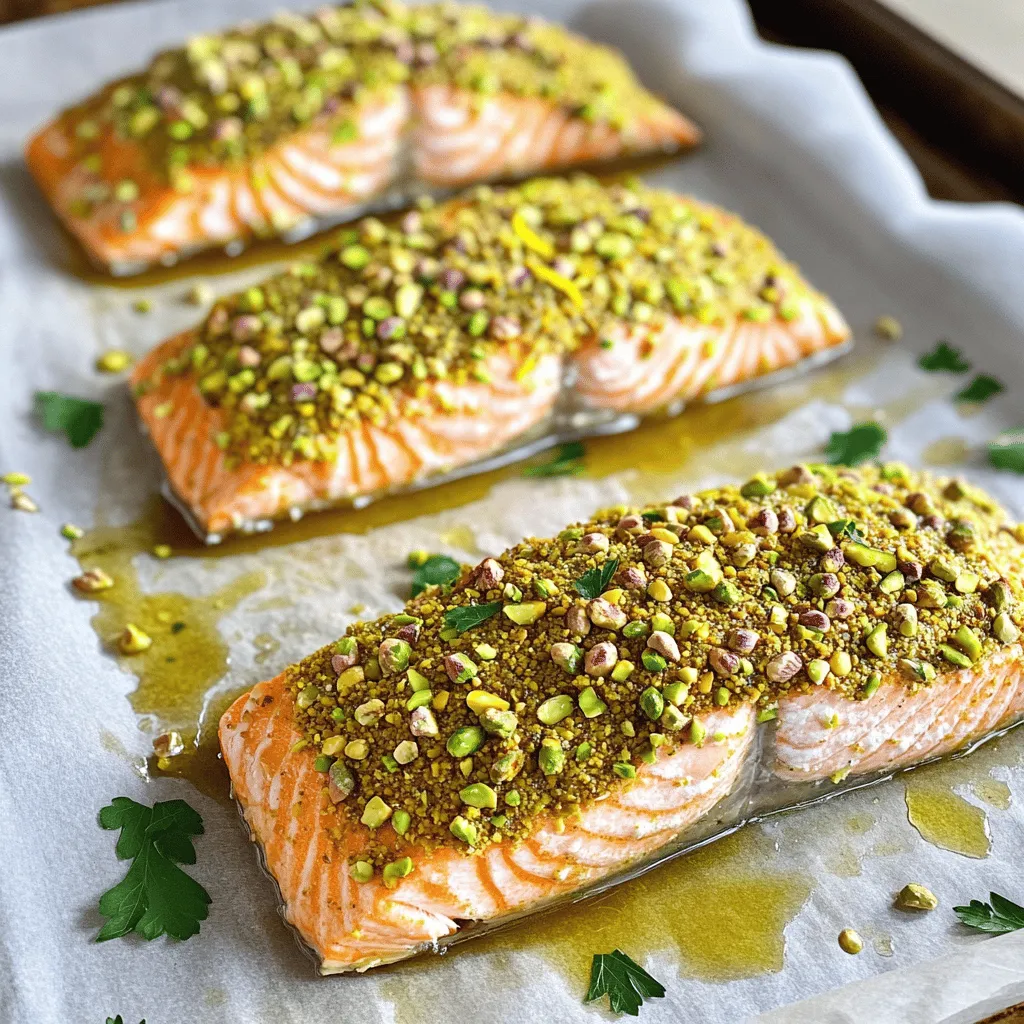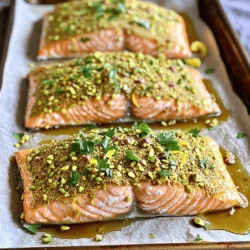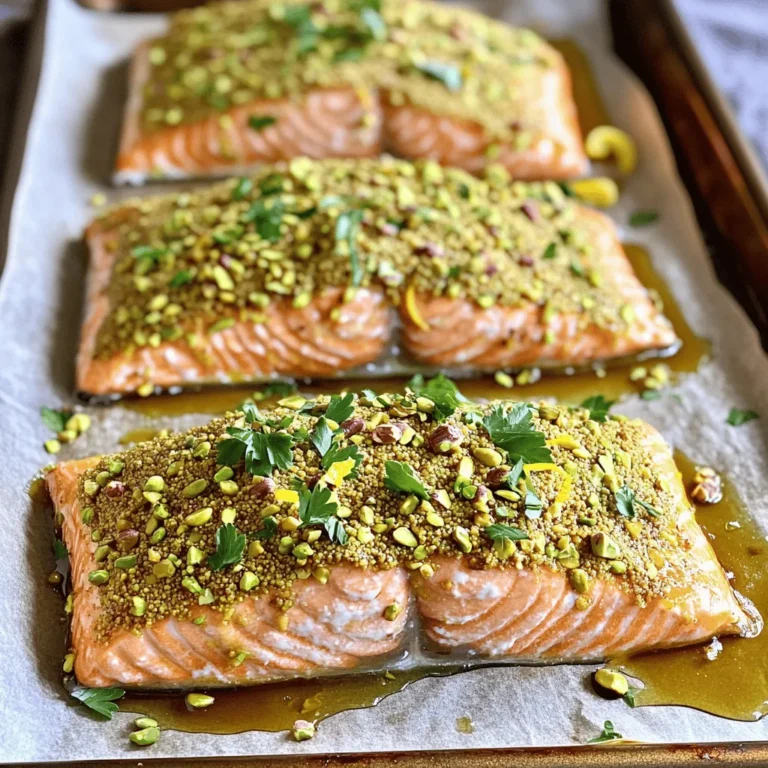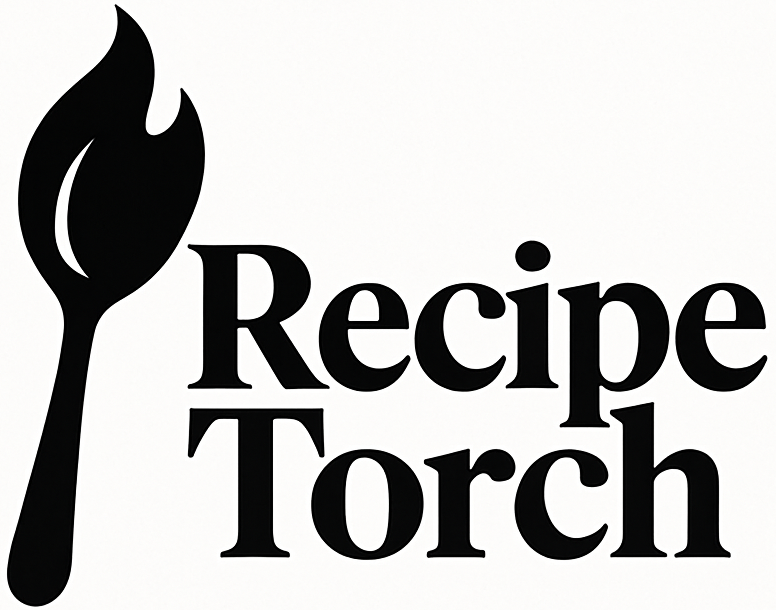Pistachio crusted salmon is a dish that brings joy to your table. This recipe combines crunchy nuts and tender fish, creating a perfect match. I will guide you through easy steps to create this delightful meal. You’ll also find tips on picking fresh salmon and ways to enhance its flavor. Ready to impress your family? Let’s dive into this tasty journey together!
Ingredients
Main Ingredients for Pistachio Crusted Salmon
To make a tasty pistachio crusted salmon, you will need:
– 4 salmon fillets (approximately 6 oz each)
– 1 cup shelled pistachios, finely chopped
– 2 tablespoons Dijon mustard
– 1 tablespoon honey
– 2 tablespoons extra virgin olive oil
– 1 teaspoon garlic powder
– 1 teaspoon freshly grated lemon zest
– Salt and freshly ground black pepper to taste
These ingredients work together to create a flavorful dish. The salmon brings rich taste and protein, while the pistachios add crunch and depth.
Optional Garnishes and Sides
You can enhance your meal with some sides. Consider these options:
– Fresh parsley, finely chopped (for garnish)
– Sautéed spinach
– Roasted vegetables
– Extra honey drizzle for sweetness
These garnishes and sides not only look good but also boost flavor. They help make your plate vibrant and appealing.
Tips for Selecting Fresh Salmon
Choosing the right salmon is key. Here are some tips:
– Look for bright, moist fillets.
– The flesh should be firm to the touch.
– Check for a clean, ocean-like smell.
– Avoid salmon with brown spots or discoloration.
Fresh salmon guarantees a tasty meal. When you have good quality fish, your dish shines. Remember, the best meals start with the best ingredients!
Step-by-Step Instructions
Prepping the Salmon
Start by preheating your oven to 400°F (200°C). This step helps cook the salmon evenly. Next, line a baking sheet with parchment paper. This keeps the fish from sticking and makes cleanup easy. Take your salmon fillets and place them skin-side down on the sheet. This method ensures even cooking and prevents them from sticking.
Making the Pistachio Coating
In a small bowl, combine Dijon mustard, honey, olive oil, garlic powder, and lemon zest. Add a pinch of salt and pepper. Whisk these together until smooth. This mixture adds flavor and helps the pistachios stick. Once mixed, spread it generously over the top of each salmon fillet. Make sure to cover them well.
Then, take your finely chopped pistachios and press them onto the mustard-coated salmon. Use enough nuts to create a nice crust. This coating is what makes the dish special and adds a crunchy texture.
Baking the Salmon
Now it’s time to bake the salmon. Place the baking sheet in the preheated oven. Bake for 12-15 minutes. Check the salmon at the 12-minute mark. It should be opaque and flake easily with a fork when done. Once cooked, remove the salmon from the oven. Let it rest for 3-5 minutes. This resting time helps keep the fish juicy.
For a nice touch, sprinkle freshly chopped parsley on top just before serving. This adds color and freshness to your dish. If you want more sweetness, drizzle a little extra honey on top.
This whole process makes a delicious meal that looks great on your plate.
Tips & Tricks
Achieving the Perfect Crispy Crust
To get that crispy crust, you need to use finely chopped pistachios. This helps them stick better. Press the nuts firmly onto the salmon. This ensures they form a nice layer. Bake your salmon at 400°F (200°C). This high heat crisps up the nuts quickly. Do not open the oven door while it cooks. This keeps the heat in, which helps the crust stay crunchy.
Best Cooking Methods for Salmon
The oven is my favorite way to cook salmon. It cooks evenly and gives a great texture. You can also grill it for a smoky flavor. If you like, pan-searing is another option. Just make sure to use a non-stick pan. This way, the salmon will release easily. Whatever method you choose, always check the internal temperature. It should reach 145°F (63°C) for safe eating.
Flavor Enhancements and Pairing Suggestions
To boost the flavor, add herbs like dill or thyme to the mustard mix. These herbs add freshness and depth. You can also sprinkle a bit of paprika for a hint of spice. For sides, roasted veggies or a light salad work well. They balance the richness of the salmon. Try serving it with lemon wedges to add zing. This dish pairs nicely with a crisp white wine, too.

Variations
Alternative Nut Crusts
You can change the pistachios for other nuts. Walnuts, almonds, or hazelnuts work great. Each nut gives a unique taste. For a sweeter touch, use pecans. Just chop them finely and follow the same steps. This keeps the dish fresh and fun.
Creative Marinades and Glazes
Instead of the mustard mix, try other flavors. A soy sauce blend adds a savory twist. Mix soy sauce, ginger, and a splash of lime. For a spicy kick, use chili paste. These options change the dish without much effort. You can also use honey and balsamic vinegar for a sweet glaze. Each choice brings its own flair.
Serving Suggestions for Different Occasions
You can serve this salmon in many ways. For a fancy dinner, plate it with risotto and asparagus. For a casual meal, pair it with rice and steamed broccoli. If it’s a barbecue, serve it with a fresh salad. Each setting lets you enjoy the flavors differently. This flexibility makes the dish special for any event.
Storage Info
Storing Leftover Salmon
After cooking your pistachio crusted salmon, let it cool. Store leftovers in an airtight container. This keeps the salmon fresh. Use the salmon within two days for the best taste. If you place it in the fridge, it will stay safe to eat.
Reheating Instructions
To reheat, I recommend using the oven. Preheat it to 350°F (175°C). Place the salmon on a baking sheet. Cover it with foil to keep it moist. Heat for about 10 minutes or until warm. You can also use a microwave, but it may dry out the salmon. Heat it for 30 seconds at a time until warm.
Freezing Tips for Long-term Storage
If you want to keep the salmon longer, freeze it. Wrap each piece tightly in plastic wrap. Then, place it in a freezer bag. Squeeze out the air to prevent freezer burn. This way, you can freeze the salmon for up to three months. When ready to eat, thaw it in the fridge overnight. Then, reheat it using the instructions above.
FAQs
How do I know when salmon is cooked?
Salmon is cooked when it turns opaque and flakes easily with a fork. This usually takes about 12-15 minutes at 400°F (200°C). You can also check the thickest part of the fillet. If it reaches an internal temperature of 145°F (63°C), it’s safe to eat.
Can I use other types of fish for this recipe?
Yes, you can use other fish like trout or halibut. Just be aware that cooking times may change. Thinner fillets will cook faster, while thicker ones may need more time. Adjust based on the type of fish and its thickness.
What can I serve with pistachio crusted salmon?
I love pairing this salmon with sautéed spinach or roasted vegetables. You can also serve it with a light salad or wild rice. These sides add color and nutrition to your plate. For a touch of sweetness, drizzle honey on top just before serving.
How to make this recipe gluten-free?
To make this recipe gluten-free, ensure all your ingredients are certified gluten-free. The Dijon mustard and honey usually do not contain gluten, but always check the labels. This way, everyone can enjoy this tasty dish! You can also use gluten-free breadcrumbs if you want a crunchier topping.
You now have a clear guide to making pistachio crusted salmon. We covered ingredients, preparation, cooking tips, and variations. Remember to choose fresh salmon for the best taste. Achieving the perfect crispy crust enhances the dish’s appeal. Don’t hesitate to try different nuts and flavors. This recipe is flexible for any meal or occasion. Store leftovers properly for later enjoyment. I hope this guide inspires you to create a delicious salmon dish. Enjoy your cooking and happy eating!


